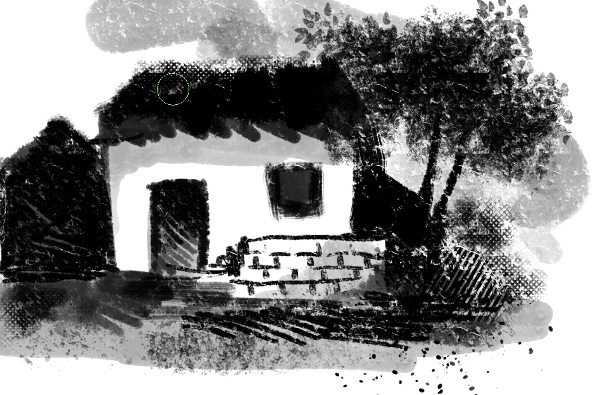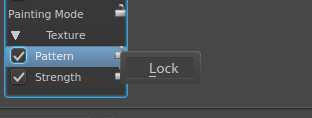Krita 2.9: Draft Brush Profiles, Locked Settings, and Cumulative Cancellation
In the just released Krita 2.9 release, one of the projects implemented in the framework of Google Summer of Code 2014 was implemented, which was developed by a student from India, Mohit Goyal. It was a rather complicated project, therefore we offer you a brief guide on the use of new functions: draft profiles of brushes, locked settings and cumulative cancellation!

Article translation: Ksenia Kuzyaeva
')
This is a long-awaited feature that many users have requested to implement: it allows Crete to memorize small changes in brush profiles without having to rewrite the original. This function can be activated in the settings window of the brush by ticking “ Temporarily Save Changes to Profiles” ( Temporarily Save Tweaks To Presets ).

Then select a profile.

Now, if you change any parameter, for example, opacity, Krita will make this profile a draft. You can determine whether a profile is draft by a small plus sign on a profile icon.

To restore the original settings, click the “ Reload Original Preset ” button.

To save new settings, simply save the profile.
The second most popular option was to block a group of brush settings (for example, opacity, brush tip, or even texture) so that they would be active, regardless of which profile was selected.
To activate it, right-click on the lock next to the parameter. Then select “Block”.

Now the parameter will not be reset every time you select a new profile.
This feature can be used to, for example, save one texture for all profiles.

Settings can be unlocked by right-clicking on the lock icon again.

There are two unlock options:
Finally, the latest innovation from Mohit
Grouped undo actions allow you to combine multiple undo actions into one. This can be useful if you are doing a lot of small strokes or you want to use memory more economically.
Cumulative cancellation is activated through the “Action Log” panel (Undo History). Right-click on an element to enable it.

After that, the cumulative cancellation can be configured by once again clicking the right mouse button on the cancel action.

You can disable this feature by right-clicking on the undo action and turning it off.
Now you can cancel more strokes! in the undo history, grouped undo actions will be marked “United” after the name.
Group of Russian-speaking users in VK: http://vk.com/ilovefreeart
Download the stable version of Krita 2.9 by one of the links:

Article translation: Ksenia Kuzyaeva
')
Draft Brush Profiles
This is a long-awaited feature that many users have requested to implement: it allows Crete to memorize small changes in brush profiles without having to rewrite the original. This function can be activated in the settings window of the brush by ticking “ Temporarily Save Changes to Profiles” ( Temporarily Save Tweaks To Presets ).

Then select a profile.

Now, if you change any parameter, for example, opacity, Krita will make this profile a draft. You can determine whether a profile is draft by a small plus sign on a profile icon.

To restore the original settings, click the “ Reload Original Preset ” button.

To save new settings, simply save the profile.
Blocked brush settings
The second most popular option was to block a group of brush settings (for example, opacity, brush tip, or even texture) so that they would be active, regardless of which profile was selected.
To activate it, right-click on the lock next to the parameter. Then select “Block”.

Now the parameter will not be reset every time you select a new profile.
This feature can be used to, for example, save one texture for all profiles.

Settings can be unlocked by right-clicking on the lock icon again.

There are two unlock options:
- Unlock (restore settings from profile) ( Unlock (restore settings from preset) ) - this option allows you to reset the settings of a locked parameter and copy them from the active profile. Thus, if the current profile of the brush did not have a texture, then using this option the brush will again appear without a texture.
- Unlock (keep current settings) ( Unlock (keep current settings) ) - this option allows you to save parameter settings, although it is unlocked. Profile will immediately become “draft”
Finally, the latest innovation from Mohit
Cumulative cancellation
Grouped undo actions allow you to combine multiple undo actions into one. This can be useful if you are doing a lot of small strokes or you want to use memory more economically.
Cumulative cancellation is activated through the “Action Log” panel (Undo History). Right-click on an element to enable it.

After that, the cumulative cancellation can be configured by once again clicking the right mouse button on the cancel action.

- The start time of the union is the time in seconds during which all strokes will be combined into one group. Thus, if the time is set to five seconds, then all strokes performed in these five seconds will be combined by Krita
- Grouping time is the time between strokes, which is necessary for Krita to consider the next stroke as part of a new group. Thus, if the time is set to one second, Krita will place strokes made after more than 1 second in a new group.
- Splitting strokes is the minimum number of final touches that can be undone without combining them. If set to 3, and make five strokes, only the first two will be merged
You can disable this feature by right-clicking on the undo action and turning it off.
Now you can cancel more strokes! in the undo history, grouped undo actions will be marked “United” after the name.
Links
Group of Russian-speaking users in VK: http://vk.com/ilovefreeart
Download the stable version of Krita 2.9 by one of the links:
Source: https://habr.com/ru/post/251803/
All Articles